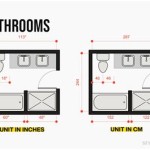Which Direction to Lay Floor Tile in a Small Bathroom
Selecting the proper direction to lay floor tile in a small bathroom is a critical design decision that significantly impacts the perception of space, visual appeal, and overall functionality. The orientation of the tile can either enhance the room's dimensions, making it feel larger and more open, or conversely, emphasize its small size, potentially creating a cramped and uninviting atmosphere. Therefore, careful consideration should be given to factors such as the bathroom's shape, natural light sources, existing architectural features, and the specific type of tile being used.
The primary goal when tiling a small bathroom floor is often to maximize the feeling of spaciousness. This involves employing techniques that visually lengthen or widen the room. However, aesthetic preferences and practical considerations, such as the ease of installation and minimization of tile cuts, also play a crucial role in determining the optimal tile direction. Understanding the principles of visual perception and applying them to tile layout can transform a small bathroom into a stylish and comfortable space.
Key Considerations: Shape and Size of the Bathroom
The shape and size of the bathroom are fundamental factors in determining the best direction to lay floor tile. In a narrow, rectangular bathroom, laying tiles lengthwise, parallel to the longest wall, can create the illusion of greater depth. This orientation visually stretches the room, making it feel longer and less confined. Conversely, laying tiles widthwise, perpendicular to the longest wall, can make a long, narrow room appear wider. This is particularly effective if the bathroom feels disproportionately long and thin.
For square bathrooms, the choice is less straightforward and depends on the desired aesthetic. Laying tiles diagonally can add visual interest and break up the boxy feel of a square room. This approach can also make the space appear larger by drawing the eye across the longest dimension of each tile. However, diagonal installations often require more tile cuts, leading to increased material waste and installation time.
The size of the tile itself should also be considered in relation to the bathroom's dimensions. Large format tiles can minimize grout lines, creating a cleaner, more seamless look that can enhance the feeling of spaciousness. However, using excessively large tiles in a very small bathroom can make the space feel even smaller and more disproportionate. Conversely, smaller tiles can create a more textured and detailed look, but excessive grout lines can visually clutter the space. A balanced approach is often the most effective, selecting a tile size that complements the bathroom's dimensions and overall design.
The presence of existing architectural features, such as a bathtub, shower, or vanity, can also influence the optimal tile direction. Aligning the tile layout with these features can create a more cohesive and aesthetically pleasing design. For example, running tiles parallel to a long vanity can visually integrate it into the floor, while aligning tiles with the edge of a shower enclosure can create a clean and professional finish.
Maximizing Natural Light and Visual Flow
Natural light plays a significant role in how the size and shape of a room are perceived. When laying floor tile, it is important to consider the direction of natural light entering the bathroom. Laying tiles in the same direction as the primary light source can enhance the room's brightness and make it feel more open and airy. This is particularly effective if the tiles have a glossy or reflective finish, which will amplify the light and create a sense of spaciousness.
Conversely, laying tiles perpendicular to the primary light source can create shadows and texture, which can add depth and visual interest to the room. However, this approach can also make the space feel smaller if the shadows are too pronounced. A balanced approach is often the best solution, considering both the amount of natural light and the desired aesthetic effect.
Visual flow is another important consideration. The direction of the floor tile can be used to guide the eye through the bathroom, creating a sense of movement and continuity. Laying tiles in a consistent direction throughout the bathroom can create a seamless look that visually expands the space. Alternatively, changing the tile direction in different areas of the bathroom can define different zones and add visual interest. For example, tiles could be laid lengthwise in the main area of the bathroom and widthwise in the shower enclosure to create a subtle distinction.
The transition between the bathroom floor and the adjacent flooring in the hallway or other rooms should also be considered. Aligning the tile direction with the flooring in the adjacent room can create a sense of continuity and visual flow, making the bathroom feel like a natural extension of the overall living space. This is particularly effective if the flooring in the adjacent room is visually similar to the bathroom floor tile.
Tile Type, Pattern and Installation Considerations
The type of tile selected and the chosen pattern significantly impact the visual effect of the floor. Rectangular tiles are most commonly used to create the illusion of length or width, depending on their orientation. Square tiles offer more versatility but may not be as effective in visually stretching or widening a small space. Large-format tiles, as mentioned earlier, can minimize grout lines and create a more seamless appearance, contributing to a feeling of spaciousness. However, careful planning is crucial to avoid excessive cuts and maintain a balanced aesthetic.
Certain tile patterns can also enhance the perception of space. A running bond pattern, where tiles are offset from one another, can create a sense of movement and visually lengthen the room. A herringbone pattern, where tiles are laid in a zigzag formation, can add visual interest and depth. A checkerboard pattern, using alternating colors or materials, can create a classic and timeless look, but it can also make a small bathroom feel cluttered if not executed carefully.
Installation considerations are also paramount. Diagonal tile layouts, while visually appealing, typically require more cuts, leading to increased material waste and installation costs. Straight layouts are generally easier and more cost-effective to install. It is also important to consider the subfloor and ensure that it is level and prepared properly before tiling. An uneven subfloor can lead to uneven tile installation, which can detract from the overall aesthetic and potentially cause problems in the future.
Grout color plays a subtle but important role. Using a grout color that closely matches the tile color can minimize the appearance of grout lines and create a more seamless look, which can enhance the feeling of spaciousness. Contrasting grout colors can highlight the individual tiles and create a more textured and detailed look, but this can also make a small bathroom feel busier and more cluttered.
The complexity of the tile layout can also affect the overall cost and time required for installation. Intricate patterns and diagonal layouts require more skill and precision, which can increase labor costs. Simple, straight layouts are generally easier and faster to install, making them a more cost-effective option for small bathrooms. It is important to balance aesthetic preferences with practical considerations when choosing a tile layout.
Ultimately, deciding which direction to lay floor tile in a small bathroom necessitates a comprehensive evaluation of the room's dimensions, natural light, existing features, tile type, and desired aesthetic. A well-considered tile layout can transform a cramped and uninviting space into a stylish and functional oasis. Careful planning and attention to detail are key to achieving a successful outcome.

Bathroom Floor Tile Layout In 5 Easy Steps Diytileguy

Learn How To Layout Bathroom Floor Tile

Laying Floor Tiles In A Small Bathroom Houseful Of Handmade

Big Tile Or Little How To Design For Small Bathrooms And Living Spaces S Of America

Small Bathroom Tile Upgrade How To

Which Direction Should I Lay The 12x24 Vinyl Tiles In Our Bathroom

How To Install Vinyl Plank Floors In A Bathroom Over Tile

Which Direction Should You Run Your Tile Flooring Well Designed

Why A Centered Tile Layout Is Bad Idea Diytileguy

The Tile Journal Of Hamilton In Woodstock Ga
Related Posts







